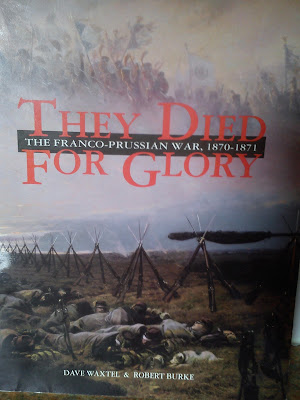The first in a little series of wargames rules that I use or have enjoyed playing.
In this outing I thought I would start with what I consider my favourite ruleset. It's not everyone's go to set for the Franco-Prussian War of 1870-71, but for me it has to be They Died for Glory by Dave Waxtel and Robert Burke.
I fell for Franco-Prussian War because I covered it at university, taught it in schools, I love the study of 19th century European history, and from a wargaming perspective am intrigued by the asymmetrical nature of the conflict - French chassepots with the small arms edge, whilst the Prussians can wheel out their superior artillery.
I won't bore you with all the game mechanics but concentrate on why I like them.
First all the order of play means that all players are involved all the time. Basically an IGOUGO system which also allows the non-moving player to fire at a moving unit at any point in that movement. But... you have to think because each unit can only do two things in any one turn. So, if you fire once you can only move once. Or move twice and not be able to fire.
This firing at a moving player's unit leads to another aspect that, for me, helps with the period feel of the rules. If a unit suffers 4 casualties it has to go prone. This nicely reflects the problems for attackers, think of the Prussian assault on St Privat where the guard were stalled by the hail of bullets whizzing their way and driving them down for cover.
 |
| French infantry |
This moves nicely into how infantry can be formed both in close and more open formations to deal with the tactical situation. Again, reflecting our understanding of the developing tactics of the time.
The rules are bloody, and they make for a very hard game for the attacking German armies. That is why it best to have at least 1.5:1 German to French ratio, or 2:1 if Prussian artillery is not in abundance. Cavalry is likely to be annihilated if it tries to charge infantry, so treat with care and judiciously.
 |
| French dragoons and cuirassiers |
The French are likely to lose most battles, especially if there is an absence of grenadiers/guards/zouaves who can be threw out in counter-attacks. But this should not be seen as a negative. Just think carefully about the victory conditions. It might be more about the French winning if they can delay an advance for X number of turns rather than the destruction of the opposing army.
A criticism of They Died For Glory is that they don't really have command and control rules. I've not found this a problem. Once players are in control, they bring their own friction to the tabletop. But a quick house rule like, any unit out of command range only has one action unless it rolls its unmodified morale or under for the second action, soon deals with that issue.
 |
| French infantry in formed firing line |
For links to games that I've put on for the Rejects see the links below.
Battle of Faux-Illy Big Lee or Fran and Fran pt2
Battle of Les Collines qui Bouges Ray
Battle of Artenay-Pas-Vraiment Big Lee or Ray
Give them a go. With well contrived scenarios, I've yet to have a boring or tight game with these rules.





Thanks for the linkbacks...I was wondering why I was picking up pageviews for some of my old posts!
ReplyDeleteAlways happy to provide links to your excellent posts.
DeleteThey're a great set of rules, we need to fit in a game with these as well. It's been sometime since our last game.
ReplyDeleteYou're right Ray and I'm starting to get that itch.
ReplyDeleteRichard, nice start to your blog!
ReplyDeleteYou and I have much in common including the FRW and 19th Century European Wars. While I have TDFG in my library since publication, I have yet to play a game with TDFG as the Rules of Engagement. Looking forward to seeing how it plays.
Thanks Jonathan. TDFG are a bloody set, and I've found that the scenarios have to be carefully crafted to make winning possible for both sides. But they are elegant in their execution and keep the players engaged throughout.
DeleteI have TDFG, but the rules I use for my FPW gaming is TTLGB - To the Last Gaiter Button.
ReplyDeleteIt's an all-in-one package with a campaign including maps and counters, as well as a set of tactical rules with rules for generating tabletop terrain.
What I love about it is that it is a grid-based set of tactical rules that lean into the iconic difference in ranges of the weapons in this war: German artillery outranges everything, but French rifles outrange German rifles. By having 1 grid = 1km, everything falls into clear range bands.
I have not played the campaign rules, but I have found that it is possible to convert historical scenarios into game terms. Here is a game I played:
https://corblogme.blogspot.com/2020/06/spicheren-play-by-whatsapp-game.html
Thanks for the heads up on TTLGB. I'll pop over to look at your post and check out the rules... though I'll stick to TDFG it's good to see the extras.
DeleteThese were the first rules I bought when I returned to the hobby after the teenage years. I really like them and I have a special fondness for them.
ReplyDeleteThere is something about TDFG that inspire a similar affection in me as well.
Delete